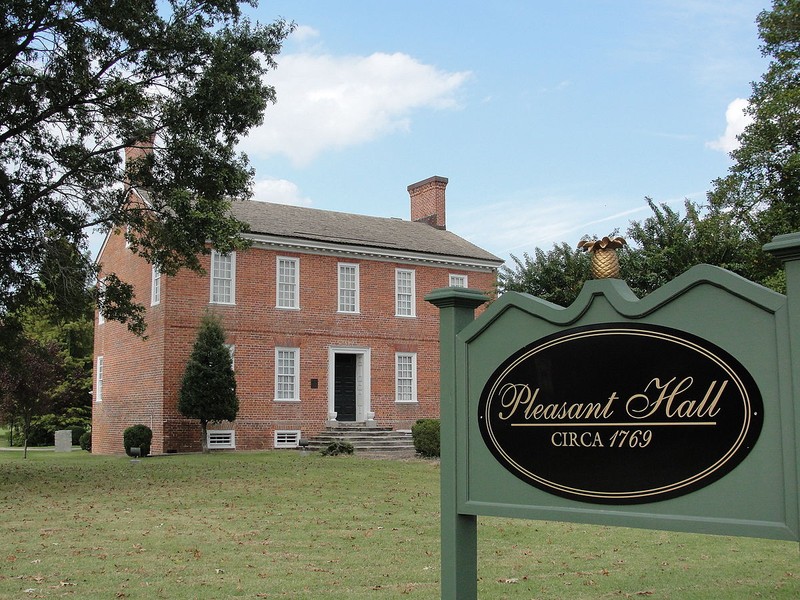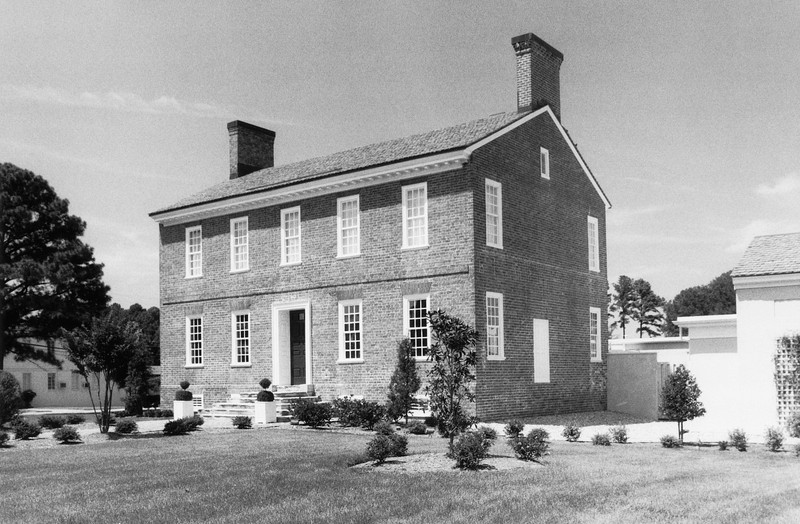Pleasant Hall
Introduction
Text-to-speech Audio
Pleasant Hall is a two story brick Georgian style home built in 1779 by Peter Singleton as a private residence. Throughout the years the building has been home to several families. Because of its architectural significance and historical past it has been designated as a Virginia Historic Landmark.
Images


Backstory and Context
Text-to-speech Audio
History
The house was listed on the Virginia Landmarks Register in October 1972 and on the National Register of Historic Places in January 1973. Robert E. Whitehead, Jr. conveyed a protective easement on the property to the Commonwealth of Virginia in 1973. Neal Kellum restored the property and built an addition for his funeral home business. The property was sold to the Kempsville Baptist Church in 2001. Currently, the church uses the building for small functions such as weddings and private parties.
Some historians believe Pleasant Hall was built by George Logan, a local merchant, in 1769. Mr. Logan's house was utilized as the headquarters for Virginia's Governor Lord Dunmore in 1775 before Dunmore retreated to his ships and bombed Norfolk. Additional research is needed regarding the construction date for Pleasant Hall.
Architectural Significance
Pleasant Hall is a two story brick Georgian style home which contains two interior end chimneys. The windows are wooden nine over nine double-hung sash. There is a one-story porch surrounding the doorway on the South exterior of the home. The rear entrance door stands nine feet tall with panels, while the front door is four feet by ten feet and has its original lock. Both doors contain their original hinges. The home features its original floors, many original brass locks and hardware, as well as the original interior wooden shutters.
Pleasant Hall's interior is divided on the first floor by a center hall which has a central arch supported on fluted Doric pilasters. The stairwell is off to the west side in the northern end of the hall. The unusual stair features heavily turned newels and an exceptionally wide molded handrail. The handrail is supported on columnn-and-pedestal balusters. The stair's open string has scrolled brackets. Especially notable is Pleasant Hall's superb fully paneled parlor with projecting chimneypiece containing full height Corinthian pilasters. Also of note is the very unusual roof framing which features a rarely used and handsomely constructed king post truss system.
Pleasant Hall was erected in 1779 by a wealthy Princess Anne County landowner, Peter Singleton, on land acquired from James Tenant. This construction date is confirmed by a dated brick below the water table on the front wall. It was Singleton who gave the plot immediately behind the house for the Princess Anne County Court House, which was erected in the 1780s, and stood until its ruins were demolished in 1972. Pleasant
Hall was sold by the Singletons in 1804, and it passed through numerous owners during the nineteenth century. In 1905 it was acquired by Dr. R.E. Whitehead. The house was listed on the Virginia Landmarks Register in October 1972 and on the National Register of Historic Places in January 1973. Robert E. Whitehead, Jr. conveyed a protective easement on the property to the Commonwealth of Virginia in 1973. Neal Kellum restored the property and built an addition for his funeral home business. The property was sold to the Kempsville Baptist Church in 2001. Currently, the church uses the building for small functions such as weddings and private parties.
Some historians believe Pleasant Hall was built by George Logan, a local merchant, in 1769. Mr. Logan's house was utilized as the headquarters for Virginia's Governor Lord Dunmore in 1775 before Dunmore retreated to his ships and bombed Norfolk. Additional research is needed regarding the construction date for Pleasant Hall.
Architectural Significance
Pleasant Hall is a two story brick Georgian style home which contains two interior end chimneys. The windows are wooden nine over nine double-hung sash. There is a one-story porch surrounding the doorway on the South exterior of the home. The rear entrance door stands nine feet tall with panels, while the front door is four feet by ten feet and has its original lock. Both doors contain their original hinges. The home features its original floors, many original brass locks and hardware, as well as the original interior wooden shutters.
Pleasant Hall's interior is divided on the first floor by a center hall which has a central arch supported on fluted Doric pilasters. The stairwell is off to the west side in the northern end of the hall. The unusual stair features heavily turned newels and an exceptionally wide molded handrail. The handrail is supported on columnn-and-pedestal balusters. The stair's open string has scrolled brackets. Especially notable is Pleasant Hall's superb fully paneled parlor with projecting chimneypiece containing full height Corinthian pilasters. Also of note is the very unusual roof framing which features a rarely used and handsomely constructed king post truss system.
Sources
“Pleasant Hall.” Pleasant Hall, 6 Apr. 2006, www.carolshouse.com/structures/pleasanthall/.
"National Register of Historic Places Nomination Form -- Pleasant Hall." https://www.dhr.Virginia.gov/historic-registers/134-0027/
“Pleasant Hall.” VBgov.com, www.vbgov.com/government/departments/planning/boards-commissions-committees/Pages/VB%20Historical%20....
"National Register of Historic Places Nomination Form -- Pleasant Hall." https://www.dhr.Virginia.gov/historic-registers/134-0027/
